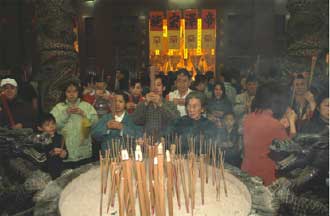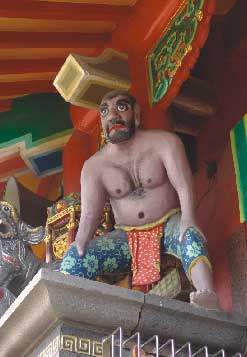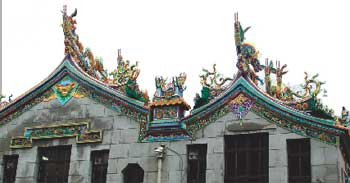A Tour of Kaohsiung's Temples / 高雄寺廟之旅
◎English Translation by Kuan-Chun Judy Chen ◎English Editor: Johanne Murray ◎Photographs by A-Kuei and Jung-Hui Pao
Temples epitomize the traditional lifestyle of the Taiwanese people. Since Taiwan is a democracy, people have the freedom of religious choice. There are many different religions represented in Taiwan. Taoism is the most widely followed of all the religions and has become an integral part of the culture. Temples have been built all over Taiwan since immigrants have been relocating here from Mainland China. The architecture, layout, totems and ceremonies of the temples make them perfect places to witness the culture and history of the people.
●The Tianhou Temple
 The Tianhou Temple is the oldest temple in Kaohsiung. Its history can be traced back to the earliest Chinese immigrants in Kaohsiung. Mainland immigrants originally came to Kaohsiung to pursue the abundance of fish in the area. In 1673, they brought Matsu with them from Meizhou, Fujian. They built a cabin to serve as a temple to this Goddess. It was rebuilt in 1948. The building still maintains the original layout and architectural style. "The God of the Door", mural painting was also on the original temple and was created by master artist, Yu-Fong Chen. The Matsu Shrine is one of the few temples listed as a historical building because of Yu-Fong Chen's masterpiece.
The Tianhou Temple is the oldest temple in Kaohsiung. Its history can be traced back to the earliest Chinese immigrants in Kaohsiung. Mainland immigrants originally came to Kaohsiung to pursue the abundance of fish in the area. In 1673, they brought Matsu with them from Meizhou, Fujian. They built a cabin to serve as a temple to this Goddess. It was rebuilt in 1948. The building still maintains the original layout and architectural style. "The God of the Door", mural painting was also on the original temple and was created by master artist, Yu-Fong Chen. The Matsu Shrine is one of the few temples listed as a historical building because of Yu-Fong Chen's masterpiece.
Matsu is the primary goddess of the fishermen. The story of Ma-ju originates from the Song Dynasty. The story states Matsu saved hundreds of people from the Ocean's clutches. After she passed away, she became a goddess and as legend has it, continues to save people who encounter disaster at sea. She later became the most popular and important goddess of southeastern China. Many temples were built to worship and honor her. Her devotees began to immigrate around the world and she became an international cultural symbol. Matsu's birthday is celebrated on the twenty-third day of the third lunar month. People tour Matsu temples and celebrate her birthday.
The temple is located on Miaoqian Road in the Cijin District. Visitors can take Bus 248 from the train station and transfer to the Ferry at the Gushan Ferry Pier. Upon arrival at Cijin Island, turn right out of the ferry terminal and walk 100-meters directly to the temple.
●Kaohsiung Guandi Temple
(The Temple of the Warrior Deity)
The temple was built to commemorate Guan-Yu, the hero of the Three Kingdoms Period. According to traditional legend, he was recognized as the Warrior Deity after his death. He also became a symbol of the Chinese Martial Arts. Records show this temple was built in 1859 and was called the Gaundi Temple. However, it is believed the temple was actually built earlier than it is recorded. After Taiwan regained it's sovereignty the temple was renamed "The Temple of the Warrior Deity" or "The Gaundi Temple".
Inside the temple there is a grand layout, with giant statues of a number of Gods. Outside, there are statues of the warriors and Guan-Yu's famous horse. Meanwhile, instead of having the "God of Doors" on the front door, the temple uses a "door pin" which is only seen in official temples. There are many celebrations held throughout the year at the Guandi Temple. On the 24th day of the sixth lunar month, a traditional birthday ceremony is held to celebrate Guan-Yu's birthday. The 6th day of the seventh lunar month is the coming of age ceremony for teenagers who have recently turned 16.
The temple is located on Wumiao Road in the Lingya District. Visitors can take Bus 248 from the train station and get off at Jung Jeng Stadium. Cross Street to the north side and continue walking north for a short distance and you will arrive at the temple.
●Cheng Huang Temple
(The Temple of the God of Judgment)
 During the Ching Dynasty, the authorities would always build a Confucius Temple and then they would build a Cheng Huang Temple (Temple for the God of Judgment). These Temples are located where the former county government once stood. Both the Confucius and the Cheng Huang Temples are categorized as official temples. The God of Judgment has been protecting Southern Taiwan since 1704. This God is believed to control both the world of the living and the world of the dead. This God is often seen with other two famous features- Qiye and Baye, which are standing next to him in the temple. This is the god Taoist people are most afraid of, as he is the god which will decide the punishment for the wrong doings people have committed throughout their lives.
During the Ching Dynasty, the authorities would always build a Confucius Temple and then they would build a Cheng Huang Temple (Temple for the God of Judgment). These Temples are located where the former county government once stood. Both the Confucius and the Cheng Huang Temples are categorized as official temples. The God of Judgment has been protecting Southern Taiwan since 1704. This God is believed to control both the world of the living and the world of the dead. This God is often seen with other two famous features- Qiye and Baye, which are standing next to him in the temple. This is the god Taoist people are most afraid of, as he is the god which will decide the punishment for the wrong doings people have committed throughout their lives.
The current temple was rebuilt in 1968. Artifacts from the original temple are on exhibition in the "Artifact Exhibition Gallery" on the third floor.
Located on Dianzaiding Road in the Zuoying District. Visitors can take Bus 301 then get off at Sheng-li Rd., or take Bus 205 and get off at the Zuoying South Station. The temple is located between Zuoying Da (Big) Road and Seng-li Road.
●The Sanfeng Temple
This temple was built to worship Nezha (also known as The Princely Lord). The temple is also known as, " The Temple of the Princely Lord". It is believed that Nezha is the third son of Lijing. The story of Nezha is a traditional legend and one of the few gods listed in Chinese history.
The Sanfeng Temple is Taiwan's most famous temple. Rebuilt in 1972, it was Taiwan's first two-story temple. Master painter Li-shui Pan painted the "God of the Door" at the Sanfeng Temple. Mr. Pan is famous for his splendid and individual style. Li-shui Pan and Yu-Fong Chen are considered Taiwan 's greatest traditional painters.
The Sanfeng Temple is located on Hebei Rd in the Sanmin District. Visitors can take Bus 205 or 218 from the train station and get off at Sanfeng Central Street.
●Yuan Shuai Temple
(Temple of the Chief Commander)
This temple was built to worship the political Chief Commander of the Eastern Jin period ─ Xiean. Unlike other temples in Taiwan, the Temple of the Chief Commander doesn't hold big pudu (universal deliverance) or big monthly celebrations. They don't burn ghost money at this temple and simply offer fruits to pay homage the ancestors. The temple is famous for being very environmentally friendly.
Located on Youchang Street, in the Nanzih District. Visitors can take Bus 218 from the train station and get off at Yuchang Street. Take Bus 205 from the Zuoying South Station and transfer to Bus 29. You will get off right in front of the Temple of the Chief Commander.
●Temple of the Three Mountain-Kings
The Temple of Three Mountain-Kings was the first Hakkan Temple. The three mountains refer to the Mt. Jin, Mt. Ming and Mt. Du in Guangdong. The legend states the gods of the three mountains helped the government through chaotic and difficult times. This is how they got the name the "Three Mountain-Kings".
The Temple of Three Mountain-Kings has a unique layout. The Main Hall and the Worship Hall are elevated higher than the other halls. Although the temple is constructed mostly of concrete, the roof is made of traditional wooden beams. This complicated structure has maintained its traditional architectural styles. Pottery statues and carvings are also visible on the outside wall and the roof.
The temple is located on Daren Road in Yancheng District. Visitors can take Bus 248 and get off at Dagong Road.
●Yimin Temple
In 1782, Shuang-wen Lin, led a group of civilian fighters against the official army in an attempt to overthrow the Ching Dynasty. The Hakkanese people of Hsinchu and Miaoli organized the civilian army and both sides suffered serious casualties and death. After the incident, Hakkanese tribes collected the bodies from the civilian army and buried them in Xinpu. Later, the Ching government awarded the temple with the name "Yimin Temple (The Temple of the Brave Civilians)". Yimin Temple in Kaohsiung was created in the likeness of the one in Xinpu and has become a very popular temple.
The reconstructed Yimin Temple was completed in 1977. Although it is a relatively new temple, the designer made great efforts to keep the traditional temple architecture. The pottery on the roof and the statues in the San-Chuan Hall are some of highlights of this temple that visitors should not miss.
Located on Baozhong Street in the Sanmin District. Visitors can take Bus 60 from the train station and get off at Mingcu Junior High School. Transfer to the Holiday Technology and Art Trolley and get off on Juemin Rd.
◎文/周盟桂 ◎攝影/周盟桂.鮑忠暉
 寺廟是台灣傳統文化的縮影。從漢人一開始移民到台灣,作為信仰中心的寺廟也跟著建立起來,而寺廟保留傳統價值,更是無庸置疑。
寺廟是台灣傳統文化的縮影。從漢人一開始移民到台灣,作為信仰中心的寺廟也跟著建立起來,而寺廟保留傳統價值,更是無庸置疑。
從廟的建築語彙、空間格局、圖騰、儀式...,見證先人生活智慧的結晶,匯集於一個有限空間場合,即使不是信眾,也會體驗莊嚴、祥和、希望與救贖等混合情感。同時,寺廟是對大眾開放的,可以滿足多種需求,歡迎一起來體驗高雄最具有特色的寺廟之旅。
高雄的特色寺廟
【天后宮】是高雄歷史最悠久的廟,可以溯及高雄最早的漢移民,因為捕魚而在旗津居留,1673年迎湄洲媽祖設立草寮為廟。現在的天后宮雖然是1948年重修,但是保留傳統寺廟格局與建築語彙,特別是彩繪大師陳玉峰的門神及泥塑壁畫,非常難得一見,列為三級古蹟(市定古蹟),是高雄古蹟中少數以寺廟形態而入列者。
媽祖是漁民的信仰中心,傳說宋朝時代媽祖於海上救人無數,死後升天,仍然不斷顯靈於海上救災救難。鄉民開始建廟祭祀,變成華南沿海最具代表性的神祉,並隨著移民而散播到世界各地,成為一項文化指標。每年農曆3月23日為媽祖生日,天后宮會有遶境祭祀活動。
◎參觀重點:彩繪大師陳玉峰之門神及泥塑壁畫、古鐘及古碑、傳統建築裝飾。
◎交通指南:位於旗津區廟前路,可以在火車站搭248線公車到鼓山輪渡站搭渡輪到旗津輪渡站,步行100公尺到達。
【武廟】主祀三國時代的英雄人物─關羽,傳說升天而為武聖,演變成中國武德典範。最早的文獻記錄高雄武廟於1859年(咸豐9年)修建,原稱「關帝廳」,但創建年代應該更早。光復後稱「武廟」或「關帝廟」。
武廟格局雄偉,內有武聖等巨型神像,外則有羅馬武士、赤兔馬等坐騎象護衛。另外,武廟的大門仿官廟形態採門釘而不用門神,是個特例。武廟祭祀活動頻繁,以每年農曆6月24日武聖生日依古法舉辦祝壽大會;農曆7月6日則有16歲成年禮活動。
◎參觀重點:雄偉正廳、門釘、羅馬武士
◎交通指南:位於苓雅區武廟路,可以在火車站搭248線公車到中正技擊館站下車。
【舊城城隍廟】清朝時代凡是縣城所在地,一定有孔廟及城隍廟,屬於官廟系統。舊城城隍廟從1704年開始就守護著南台灣。城隍爺是陰界判官,是非功過,冥冥中城隍爺自有盤算,就好像拜亭中高掛的「自問心」算盤一樣,人世間的不解也會來找城隍爺評斷。加上陰森威嚴的七爺、八爺俟立兩旁,城隍廟是最具有震懾力量的廟宇。
現在的舊城城隍廟於1968年重建完成,舊廟留存下來的文物陳列在三樓「文物陳列館」內。
◎參觀重點:自問心算盤、七爺八爺
◎交通指南:位於左營區店仔頂路,可由火車站搭301線公車在勝利路口站下車,或205線公車在左營南站下車。
【三鳳宮】主祀哪吒三太子,又稱「太子廟」。傳說哪吒是唐朝軍事家李靖的第三個兒子,哪吒是少數以兒童身分而入列中國神祉,算是比較特殊的例子,為傳奇小說中的經典人物。
台灣太子廟中就以三鳳宮最為顯赫,1972年重建時首開二層樓式廟宇的先例。三鳳宮的門神為彩繪大師潘麗水的傑作,可以找找看他的簽名,畫風華麗而莊嚴,相當具有觀賞價值,與陳玉峰並列為台灣民俗彩繪一代宗師,可以請到兩位大師或是他們的傳人來彩繪門神的都是香火鼎盛的寺廟。◎參觀重點:哪吒三太子像、彩繪大師潘麗水門神
◎交通指南:位於三民區河北路,可以在火車站搭205、218線公車到三鳳中街站下車。
【元帥廟】右昌元帥廟主祀謝安,謝安是東晉文武兼備的政治家典範,元帥廟是台灣少數拜謝安的寺廟。
元帥廟為右昌地區的莊頭廟,元帥廟不普渡、不「做牙」(農例每月初二、十六拜拜)、不燒金,以水果鮮花取代牲禮,只在農曆6月15祭祖,可謂最講究環保的廟。
◎參觀重點:環保的祭拜、神桌案下虎爺
◎交通指南:位於楠梓區右昌路,可由火車站搭218線公車在右昌街口站下車。或搭205線於左營南站轉搭29線公車,直接在元帥廟站下車。
【三山國王廟】原是客家人的神祉,三山是指廣東省潮州府巾山、明山、獨山三座山,傳說各有山神濟世;或各有節義之士協助朝廷平亂,而被褒封為「三山國王」。
三山國王廟的建築格局特殊,中間正殿及拜亭為挑高空間,兩邊各有兩層樓的護龍。牆面雖為水泥構造,但是屋頂仍維持傳統三通五瓜式木樑及複雜的柱頭斗拱構造,屋頂及外牆有很豐富的剪黏、泥塑、交趾陶等裝飾,廟體非常具有可觀性。
◎參觀重點:三通五瓜柱樑、柱頭斗拱、廟體裝飾
◎交通指南:位於鹽埕區大仁路,可由火車站搭248線公車到大公路口站下車。
【義民廟】1782年打著反清復明旗幟的林爽文起事,在台灣的新竹、苗栗一帶與官兵及客家人組成的民兵對抗,雙方死傷慘重。林爽文之亂平息之後,客家人收集民兵骨骸葬於新埔,清廷賜為褒忠義民廟。高雄義民廟則是分祀而來,逐漸演變成香火鼎盛的廟。
現今義民廟為1977年改建完成,雖然是新式廟宇,但是傳統廟宇的建築語彙與裝飾仍非常注重,例如廟屋頂的剪黏與交趾陶甚為精彩,三川殿下的憨番扛大柱傳神有趣。
◎參觀重點:剪黏與交趾陶、憨番扛大柱
◎交通指南:位於三民區褒忠街,可由火車站搭60
路公車在民族國中站下車。或搭「假日科技藝術之旅專車」在覺民路口站下車。
寺廟的禮儀與禁忌
The DOs and DON'Ts of visiting temples
禮儀 Dos
進寺廟並不一定就要拜拜,如果與您的信仰相衝突,當個有禮貌的參觀者也是非常歡迎的。如果您想表達敬意,對著正殿中間的主神雙手合十鞠躬即可。
Although it isn't necessary to burn incense or pray to the gods. When entering the temple it is considered good manners to simply press your palms together and nod towards the deity.
禁忌 DON'Ts
台灣是開放的社會,禁忌已經非常少,寺廟也是,但還是有一些舉動是不適合的。
◎不要大聲喧譁
◎不要用手指神明
◎不要走到正在祭拜者的前方
◎不要走中間的門,那是神走的;通常由右門進、左 門出。
Taiwan is an open society, so there are few taboos. However, please be aware of the following:
Do not speak or laugh loudly in the temple.
Do not point at gods.
Do not disturb people who are praying.
Respect these holy places as you would any church, mosque or synagogue etc.
It is believed the doors in the center of the doorway are used only by gods and should not be used by people. Usually, people enter the temple through the door on the right hand side door and exit from the left.